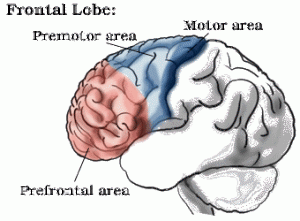There are three basic models to explain ADHD:
Model I – Frontal/Pre-Frontal Lobe Dysfunction
The frontal lobes, and especially the pre-frontal lobes, are involved in executive reasoning and inhibition of responses(Biederman et al, 2004).
- To explain, when you weigh possible solutions to a problem, evaluating the strengths and weaknesses of each possible solutions and finally choosing one, you are engaging in executive reasoning. ADHD can be thought of as a deficit in focusing, or a difficulty attending to the critical/relevant information and ignoring the distracting/irrelevant information. Thus, with a deficit in focusing, you might place too much importance on a minor strength or dismiss a serious weakness. This would mean your executive processing would not be very good.
- The frontal lobe also contains the motor cortex, making it easy for the decision-making areas of the frontal lobe to initiate, or inhibit, some kind of action. When you need to take quick action after a decision, the decision-making areas might send a message to the motor areas in effect saying, “Do it – now!” However, when you need to wait and see what happens, your decision-making areas might send a message to the motor areas to inhibit response, in effect saying, “Wait! Don’t do anything – see what happens and then we’ll decide what to do next.”
Thus, in this model, ADHD is thought to stem from problems in the Frontal and Pre-Frontal lobes, which is why people with ADHD often show problems in executive functioning, which could lead to impulsive behavior. This model fits well with our understanding of the common symptoms of ADHD, and so is appealing.
However, the model has some problems:
- First, there are many areas of cognitive functioning that include the frontal lobes, especially the pre-frontal lobes. Thus, saying that the problem is somewhere in the frontal lobes is not a very specific explanation. Imagine that when you start your car, you hear a loud and disturbing grinding noise. You take the car to a mechanic who hears the noise and says, “It’s probably something wrong under the hood.” This is very likely correct… but it’s not a very specific explanation of the problem.
- Second, if the root or underlying cause of ADHD lies in the frontal lobes, then we would expect the cognitive problems that are associated with ADHD to be fairly consistent, and to be linked to the work of the brain that happen in the frontal lobes. While there are a group of problems that are seen consistently in people with ADHD, they vary from person to person. In other words, we can show a list of problems that are common in most people with ADHD, but not in every person with ADHD. Two individuals with ADHD will show some of the same problems, but not all of the same problems.
- Third, stimulants like Ritalin have been shown to be effective in treating ADHD, but we have no specific explanation for why stimulants would improve the functioning of the frontal lobes. Some studies show low levels of stimulants help overall brain functioning (which is why people drink caffeine) but we do not have much evidence to show how stimulants would be especially helpful in frontal lobe functioning.
Model II – Broad Neural Network Dysfunction
This model holds that ADHD is caused by general problems in the “wiring” of the brain. Thus, it is not a problem that is mainly in any one area; rather, it is a widespread problem all across the brain.
- This model would explain why a stimulant like Ritalin might generally improve cognitive functioning all over the brain, why other medications might also work, and why two people with ADHD show different deficits.
- If it helps, imagine a friend builds a house, and hires a careless electrician to install all the electrical wiring. After he moves in, he might encounter odd electrical problems; for example, the electricity to the living room may be shut off at unexpected times. Unfortunately, since the wiring is hidden behind walls and panels, your friend might not be able to determine that the problem is caused by bad wiring.
- Suppose he decides that the problem is caused by having too many things plugged into the outlet behind the stereo. As a result, he runs extension cords from the other outlets to the stereo and TV, and tries to power each piece of equipment from a different outlet. This might be somewhat helpful because it compensates (but does not correct) the bad wiring in the house.
However… this model is not perfect either:
- This model does not explain why a stimulant like Focalin (a specific shape of the Ritalin molecule), which acts primarily in the basal ganglia, would be more effective than other shapes of the Ritalin molecule.
- Further, as with the frontal lobe model, this model is not a very specific explanation for ADHD.
- However, there may be different causes for ADHD, and so it may be unreasonable to expect one model to explain all aspects of the disorder.
Next post: Model III – Deeper Brain Structure Dysfunction